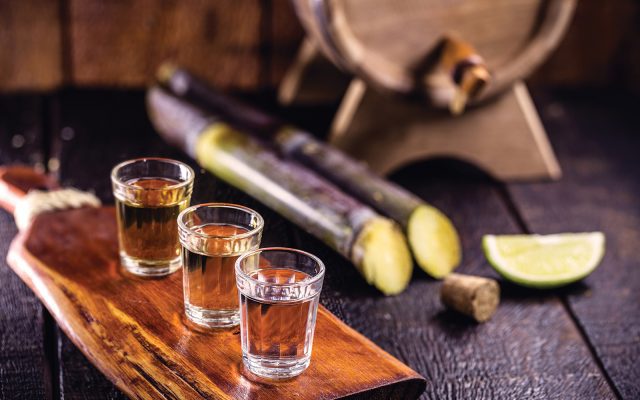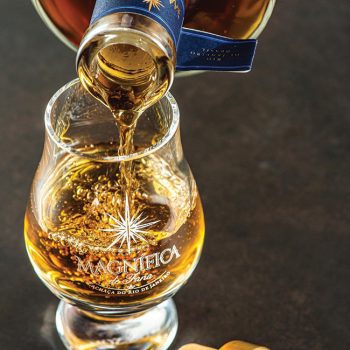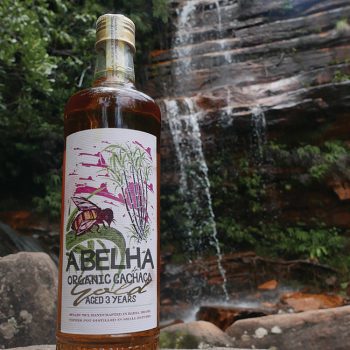Cachaça takes on the world
A new category for more artisanally produced cachaça has inspired Brazilian producers to attract new consumers to the spirit.

*This feature was originally published in the March 2024 issue of The Spirits Business magazine.
Brazil’s national spirit, while massive in its home country, isn’t particularly strong when it comes to export. There are those that hope a new quality-focused category definition may help to change that.
Cachaça can be divided into two broad styles, primarily defined by the way it’s distilled. The vast majority, 70% in 2021, according to the CBRC (Centro Brasileiro de Referência da Cachaça), is industrially produced, using column stills. The remainder is produced in pot stills, known as artisanal cachaça, or cachaça de alambique. It’s the latter style that was officially recognised by Brazil’s Ministry of Agriculture in the spring of 2023.

Among the proponents of this change was Francesco Taddonio, associate partner of Cachaça Magnífica. “There are hundreds of pot still distilleries scattered around the Brazilian territory, all of them quite small,” he says. “The giant producers always opposed the definition of a separate category for pot still cachaça. We at Magnífica, together with several other quality pot still distillers, lobbied intensely with the relevant authorities to create the cachaça de alambique category, and the ability to mention this on labels.”
The regulations are simple, he explains. To qualify, a cachaça need only be 100% copper-pot-distilled in batches, with no further restrictions on esters, proof or acidity, for example. In Magnífica’s case, triple pot still distillation is used, a traditional method that the brand brought back into use in 1985.
“It’s important to let clients and consumers know how the product is distilled because the final result is clearly different – not necessarily better, as this depends on your palate, and the distiller’s skill – as well as more expensive,” says Taddonio. “The definition of this new subcategory marks a turning point for cachaça exports. Instead of being known only for its cheap brands, it will allow the emergence of new super-premium ones, competing on a par with super-premium brands in other categories, such as single malt, Cognac or Tequila.”
Hamilton Lowe, co-founder of another artisanal cachaça, Yaguara, has experienced the positive reception of this category first hand. “We see much better consumer retention if their first experience is an artisanal cachaça,” he says.
“The distinction is as important as it is for mezcal,” believes Nate Whitehouse, co-founder of Drifter Spirits, which includes Avuá Cachaça in its portfolio. “For our brand, it’s important to communicate where it’s made – on a small family farm north of Rio – and the care taken to make our artisanal cachaça.”

Tom Stockley, co-founder of cachaça brand Abelha, says: “The real opportunities for the more artisan cachaça brands are in international markets, where consumers want to know how products are produced, where they are produced and using what ingredients.” He adds that the distinction is vital for brands like his to stand out.
Fubá Cachaça founder Raf Agapito agrees that the new definition is particularly important when it comes to export markets. “Industrial-style cachaça might have caused more damage than good for the category, as usually these brands are first to market, they convey the image that cachaça is cheap and rough, and only good as a Caipirinha ingredient,” he says. “Cachaça de alambique represents the culture of each region, and showcases the craft of the distiller. There should be clear ways for the consumer to tell both types of cachaça apart.”
There are those, meanwhile, that see the benefits of both broad styles contributing to a varied category. “Industrial cachaça played an important role in opening up the foreign market,” believes cachaça activist and cachaça sommelier Milton Lima. “But it is crucial that consumers understand the diversity provided by the category, through the variety of colours, aromas and flavours of Brazilian terroirs that represent our richness and diversity.”
Education is key
Felipe Jannuzzi, co-founder of Mapa Da Cachaça, a project created to provide information about the spirit, also believes that educating consumers is key. “Producers must be able to communicate all the specifics of their process, with the distillation in copper alembics one of the most relevant,” he says. “For a better experience, people need to understand what they are drinking, and the differences between all of the kinds of cachaças we have in this complex and beautiful category.”
The category is indeed complex, well beyond the distinction between artisanal and industrial – and becoming more so all the time, as producers continue to innovate. One aspect receiving significant attention recently is wood ageing.
“This is an area that has not been properly explored in the past, but I see it growing rapidly, as distillers are experimenting with different methods, such as solera,” says Agapito. “They’re also turning to the vast range of native Brazilian woods for the ageing of cachaça.”
Stockley says: “Brazil has over 25 indigenous woods, so we’re constantly experimenting with unique ageing, and believe this can be a strong selling point for us, the cachaça segment and Brazil.” He adds that Abelha recently launched its Reserve product in the US, aged in American oak for three years.
Whitehouse also mentions the potential offered by Brazil’s native woods. “We’re continuing to talk to markets about the fascinating variety of wood used in Brazil to age cachaça, like amburana, bálsamo, and tapinhoã,” he says, adding that there are also plans to release a falernum made with cachaça as part of the Avuá range.
More generally, Jannuzzi is seeing potential in the growing use of new oak, where used barrels were more commonly used. Beyond wood ageing, he speaks of producers finding ways to reflect Brazil’s diversity through its national spirit. “Producers are starting to understand that different places make different cachaças, and the concept of terroir is becoming more diffused in the market,” he says, highlighting the recent introduction of the category’s first Denominação de Origem, for the Paraty region.
Alex Jorganes, brand manager for cachaça brand Capucana at parent company Vantguard, also speaks of this growing sense of place in the category, saying that the brand evokes “the concept of Brazilian terroir, made using three types of cane that each provide unique organoleptic profiles’’. He highlights the innovative approach to ageing here too, with the use of barrels formerly used to mature Bourbon and Islay Scotch whisky, as well as native woods.
Finishing school
For Lowe, there’s potential when it comes to finishes, as well as different ABVs, giving the example of Yaguara’s limited edition Still Strength in Europe. “Bartenders are enjoying overproof products for cocktail development. This was our product to cater to that trend,” he says.
This raises the subject of serves and cocktails, one that’s particularly interesting when it comes to cachaça, invariably associated with just one cocktail.
“We want to show more people the Caipirinha, but cachaça is no one-trick pony, so it’s about showing the drink in a variety of occasions and throughout the year – it’s not just a drink for summer,” says Stockley.
For Agapito, the way to do this was to open a cocktail bar in Portugal’s capital, Copa Lisboa, focused on cachaça cocktails. “Serving suggestions are an element of innovation that we consider crucial, showing customers that there’s a whole universe of cachaça drinks to be explored.”
The potential is there, with receptive and better-educated consumers as a result of the growth of other cane-based spirits. As Taddonio puts it: “The huge development of premium rums has generated a large following for everything about sugarcane. Rhum agricole has already benefited, and in a minor way Haitian clairin too.”
Lowe agrees about aligning cachaça with the broader rum category. “The main consideration is to help consumers understand that cachaça is Brazilian-style rum, with its own flavour profile,” he says. “This would allow them to feel more familiar with the category, and use it in drinks beyond the famous Caipirinha.”
What remains, most agree, is to spread the word, with the new category definition one significant step towards this. “There is still a long way to go,” says Lima. “Although cachaça is an innovation for the foreign market, and a highly sustainable product, the lack of information and dissemination about it abroad is still an issue that needs to be addressed.”
Jorganes says: “We need to reach the next phase, which is the final consumer. We’re talking about a category in which the raw material is essential to give character, which is very much in line with trends regarding the search for purity and a return to origins. Some new-wave cachaças are awakening interest, serving as the spearhead of the category.”
For Agapito, the cachaça category’s diversity is a double-edged sword, both an asset and a potential hindrance. “All of that choice could be overwhelming,” he says. “We must develop better and simpler ways to categorise each style, region, age statements and so on, to reach new consumers.”
A distinction between industrial and artisanal products seems like a good place to start, with clearer definitions beneficial to the overall category, particularly when it comes to introducing it to the rest of the world.
Related news
Inside the ‘spiritual home’ of Scotch
